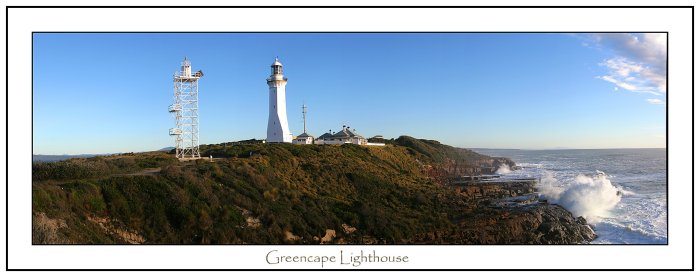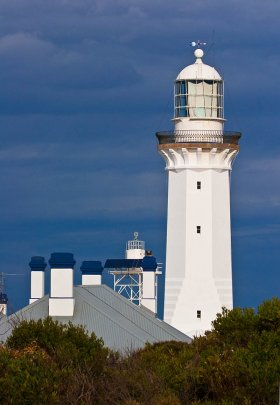
Photo - Gary Searle
After
hours of diligent research, worldwide correspondence and lobbying, LoA
member Doug Boleyn submitted an application to Engineers Australia for
Green Cape lighthouse (26km SSE of Eden on the South Coast of NSW)
to be recognized as a National Engineering Heritage Landmark.
Engineers Australia is the national forum for the advancement of
engineering and the professional development of its 80,000+
members. Engineering Heritage Australia is Engineers Australia’s
peak heritage body.
Doug’s
application was successful and on 20th July, Engineers Australia had
accorded Green Cape Lightstation recognition as a National Engineering
Heritage Landmark.

In his
letter of acceptance, Bruce Cole Convenor of Heritage Recognition
Committee mentions:
“The
Heritage Recognition Committee has discussed the nomination. We consider
it to be one of the best-produced documents that we have received, and
we compliment Doug Boleyn on his comprehensive research
and excellent presentation. We are agreed that the Lightstation
should be awarded an Engineering Heritage National Landmark.”
Recognition by Engineering Heritage Australia of an engineering work as
a National Engineering Heritage Landmark does not come easily. Green
Cape lighthouse now becomes the first lighthouse to be awarded this
honour and is joining 39 other magnificent works around Australia of
such diversity as Sydney Harbour Bridge, Snowy Mountains Scheme, Trans
Continental Railway, Coolgardie Goldfields Water Supply Scheme,
Waddamatta “A” Power Station in Tasmania, Kuranda Range Railway in
Queensland and the Lake Burley Griffin Scheme which have been similarly
recognized.
In his 59-page application document Nomination of Green Cape
Lightstation for Recognition as a National Engineering Heritage
Landmark, Doug states these reasons for nominating his favourite
lighthouse.
Green
Cape lightstation is of State significance because:
1.
Construction of the Green Cape lighthouse was an integral part of a
plan to warn mariners of the more dangerous unlit places of the
Australian coastline. The decision arose from a resolution of the
Inter-Colonial Conference of 1873 at which the principal marine officers
provided the first Australia-wide evaluation of navigational
needs. The collective decision was an early example of the
cooperation between the Australian Colonies that led to the creation of
the Commonwealth of Australia.
2. At the time of its construction the Green Cape
lighthouse was reputed to be the largest mass concrete structure in the
Australian colonies and until the time of its decommissioning, remained
the tallest lighthouse in NSW
3. Green Cape light has associations with major and
historically important figures like James Barnet, Colonial Architect
Department of Public Works NSW, and Francis Hixson, President of the
Marine Board of NSW.
4. During World Wars I and II, Green Cape was strategically
important; it is understood that many incidents are buried in wartime
records that are still subject to censorship.
5. Green Cape was the second one (by 3 years) of a
pioneering group of mass concrete lighthouses, and although the faceted
design made the construction easier, the remoteness of the site, deep
foundations combined with the absence of major plant and reliance on
local materials made its construction a difficult task.
6. It is one of the iconic lighthouses of Australia. Green
Cape’s distinctive design with its square base merging into an
octagonal form was a break from the traditional circular tower of other
lightstations. The styling is rare, with the display of accentuated
bluestone corbelling which typifies the Victorian Mannerist style,
combined with the double curved gunmetal balcony railing employed by
Barnet in his design. Green Cape was the first and tallest of only two
lighthouses constructed in such way.
7. As part of a cohesive group of late 19th C and early
20th C lighthouses in NSW, it demonstrates the incremental changes from
1880 to the present in the design and construction of lightstation
complexes and in the evolution of lighthouse technology.
8. The long Aboriginal association with the area and the
number of pre-white settlement sites throughout the precinct such as
middens and initiation grounds have archaeological and research
potential.
9. Research potential is also apparent examining the
logistics involved in servicing such a remote construction and
operational sites that were only accessible by sea.
10. During the 100 years of its manned operation, Green
Cape Lightstation was a social and cultural centre for the local
community and surrounding properties. Until road transport became
practical in the 1930s, unloading of stores, which came by sea via
Bittangabee Bay for both the lightstation and the surrounding, settlers
became a co-operative and social occasion.
11. The still visible wreckage of vessels and the nearby cemetery
are testament to the rescue and ministering role performed by the
light keepers and their families. This involved not only
performing rescues in dangerous conditions, but providing first aid,
comfort and shelter to survivors and recovering and burying the dead.
12. The area was culturally important to the local aboriginal
people. The Cape [Bundooro] was a men’s area and was also used
for teaching purposes. Bittangabee Bay [Pertangerbee] was both a
camp place and teaching ground. The land still continues to have
important spiritual and physical significance to the local Tauaira
people.
13.
The lightstation has a high degree of integrity. The lighthouse is
basically intact with items, or at least photographs (when the real
piece was not available) of replaced equipment being displayed on site.
Most of the buildings of substance from the 1881- 83 period still
remain. Little different from the day the light was first
exhibited, it readily allows the working conditions of the keepers and
living conditions of lighthouse families in an isolated environment to
be appreciated. The semi-detached Assistants’ quartes have been
modified into one smaller and one larger residence.

|
